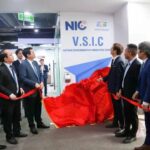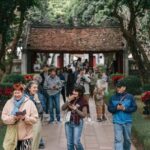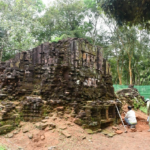A simple online search will yield countless videos of tourists filming their attempts to navigate the bustling streets of Vietnam. Whether they’re at a traffic light, zebra crossing, or just an ordinary road, the line between vehicles and pedestrians in this country is blurred, to say the least. And for foreigners, this unique traffic dynamic often induces confusion, fear, and even pedestrian rage.
Contrary to what some may believe, crossing the road in Vietnamese cities is not a lawless or chaotic endeavor. In fact, there is a fundamental difference between how it’s done here and in countries like the U.S. or Australia: the concept of ‘Right of Way.’ For instance, when a traffic light turns red, pedestrians have the right of way and are expected to be given unimpeded passage by vehicles.
The traffic laws in Vietnam dictate that vehicles must stop at a red light. Additionally, pedestrians are allowed to cross on a green walk signal. However, the reality is often complicated by motorbikes that don’t stop and turn right at intersections. This creates a unique challenge for pedestrians.
What sets Vietnam apart in terms of traffic management is the sense of shared responsibility and community consideration. While the right of way is not always clear-cut, everyone is expected to follow the rules and look out for one another. It may seem unusual, but this system works remarkably well in the context of Vietnamese culture.
With one of the highest motorcycle ownership rates in the world, Vietnam’s traffic is characterized by a constant flow of vehicles. As a result, finding a safe gap to cross the road can be challenging, leading to close interactions between pedestrians and motorists.
I admire the way Vietnamese people coexist and navigate their busy roads. This is evident in the way they cross the street, prioritizing community over individual rights. It’s not about ‘I have the right to go’ but rather a collective understanding that we all need our space to reach our destinations safely. So, embrace this unique experience with confidence during your next visit to Vietnam.
Recently, a new decree has brought about significant changes in the relationship between pedestrians and motorcyclists. Fines have been increased for various offenses, including riding on sidewalks, disregarding traffic lights, wearing earphones while riding, and making illegal right turns at red lights. These stricter regulations are a step towards making Vietnam’s roads safer for all users.
With a population of approximately 100 million, Vietnam is comparable in size to New Mexico in the U.S., which has a population of around three million. As a result, the congestion in Vietnamese cities like Ho Chi Minh City is a persistent reality, and so is the challenge of dodging traffic when crossing the street.
While the revised fines and road rules are expected to influence the behavior of local motorists, tourists can benefit from seeking guidance online. Learning simple gestures, such as raising your arm and waving, making eye contact with riders, and walking slowly, can greatly improve your navigation of Vietnam’s busy streets.
The golden rule for staying safe in this chaotic yet captivating environment? Don’t step backward in a moment of panic. Unless it’s an extreme situation, standing still and allowing motorcyclists to maneuver around you is the best strategy for staying safe.
For tourists adventurous enough to rent a motorbike and join the fray, remember to treat your fellow commuters with respect and care. This sense of community and consideration is what keeps Vietnam’s traffic flowing, despite the apparent chaos.
Unveiling the Martial Arts Legacy: Vietnam’s Quest for UNESCO Recognition of Binh Dinh’s Ancient Combat Traditions
Deputy Prime Minister Mai Van Chinh has endorsed a proposal to UNESCO, advocating for the inclusion of “Binh Dinh Traditional Martial Arts” on the esteemed Representative List of the Intangible Cultural Heritage of Humanity. This significant step forward recognizes the unique and invaluable contribution of this martial art form to Vietnam’s rich cultural heritage.
Vietnam’s Semiconductor Industry Lights Up with the Launch of the Innovation Centre in Hanoi
The launch of the VSIC is a significant move by FPT Corporation, NIC, and their partners, demonstrating their dedication to fostering a robust and sustainable semiconductor ecosystem in Vietnam. This joint effort positions the country as an emerging hub in the semiconductor industry, making it a desirable destination for investors and businesses alike.
Captivating Vietnam: Elevating Cities’ Charm through Exceptional Travel Experiences
The meeting served as an invaluable platform for Vietnamese participants to exchange insights and expertise in tourism management, fostering stronger cooperation with international peers. By playing host to this distinguished gathering, Hanoi reinforced its dynamic leadership in promoting interconnectedness and a sustainable future for the tourism industry.
The Restoration of Ancient Towers: Indian Experts Bring New Life to Vietnam’s My Son Sanctuary
The E and F tower groups at My Son Sanctuary, a UNESCO World Heritage Site in Vietnam’s central Quang Nam Province, are undergoing restoration work once again. This time, Indian experts are at the helm of a significant conservation project, generously funded by the Indian government to the tune of almost $4.85 million.









